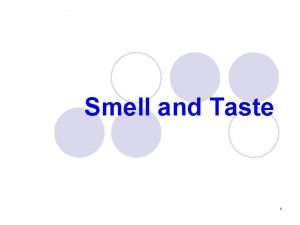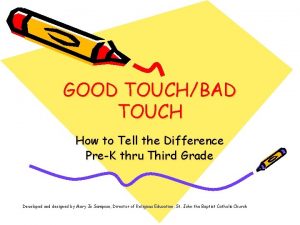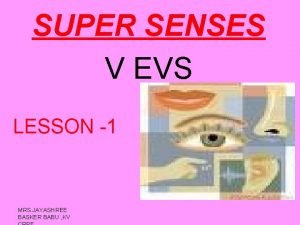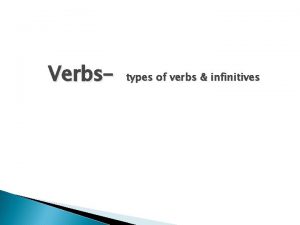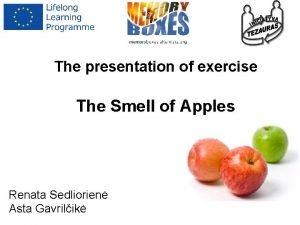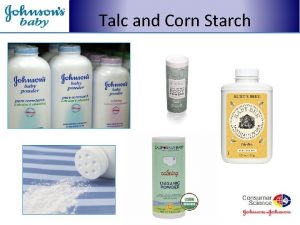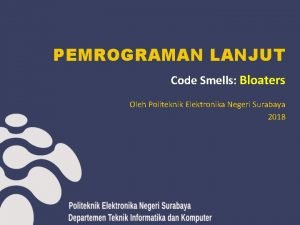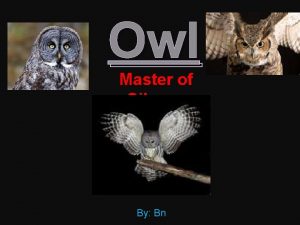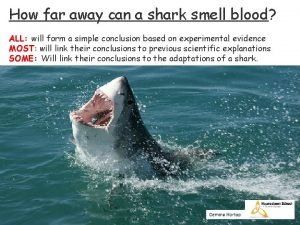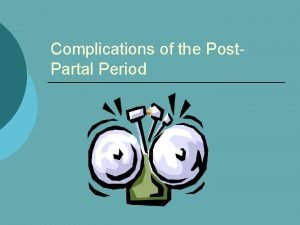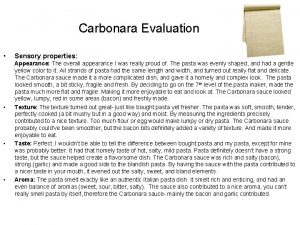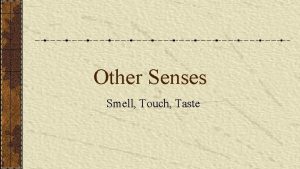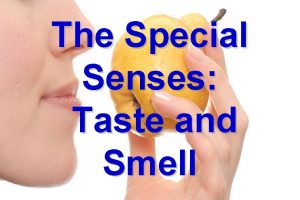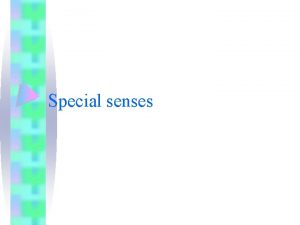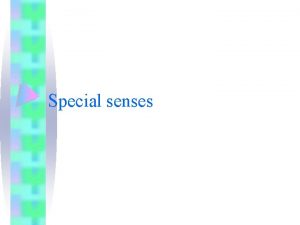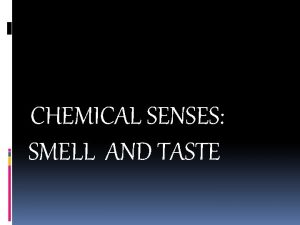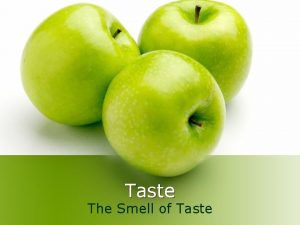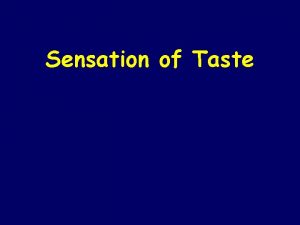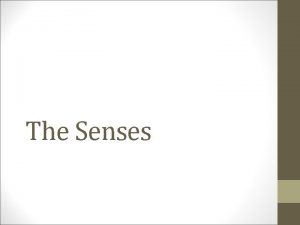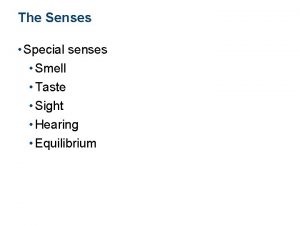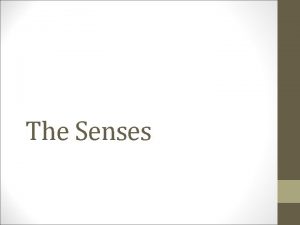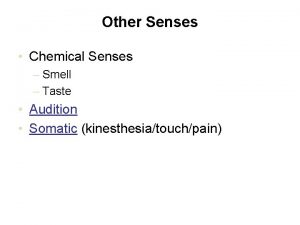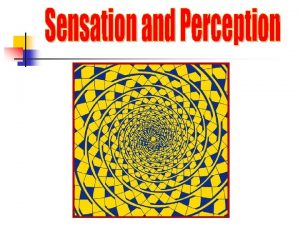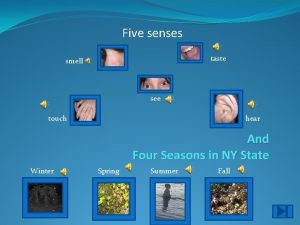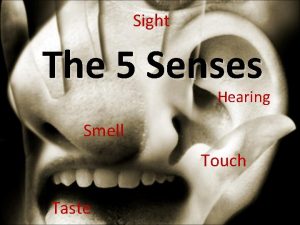Unit 6 Senses ppt 1 Touch Taste Smell



















- Slides: 19

Unit 6 Senses ppt 1 Touch, Taste & Smell Chapter 16

Sense Organs Copyright © The Mc. Graw-Hill Companies, Inc. Permission required for reproduction or display. Superciliary ridge Superior palpebral sulcus Eyebrow • General Senses Upper eyelid Eyelashes Iris Palpebral fissure • Chemical Senses • Hearing and Equilibrium Pupil Sclera Medial commissure Lateral commissure Lower eyelid Inferior palpebral sulcus Tarsal plate © The Mc. Graw-Hill Companies, Inc. /Joe De. Grandis, photographer Figure 16. 22 Copyright © The Mc. Graw-Hill Companies, Inc. Permission required for reproduction or display. • Vision Helix Triangular fossa Antihelix Concha External acoustic meatus Tragus Antitragus Figure 16. 10 Lobule (earlobe) 16 -2© The Mc. Graw-Hill Companies, Inc. /Joe De. Grandis, photographer

What is a sensory receptor? • Sensory receptor is any structure specialized to detect a stimulus. • Some are simple nerve endings • Some are sense ORGANS (nerve endings combined with tissues that enhance or moderate a response to the stimulus

Sensory Receptors transmit 4 kinds of information • 1. Modality---type of stimulation or sensation it produces. EX: vision, hearing, taste, touch • 2. Location---indicates which nerve fibers are firing, receptive field. Brains ability to determine the location depends on the size of the receptive field. EX: back~7 cm finger 1 mm • Being touched 5 cm might feel like 1 on back, being touched at 2 mm might feel separate. 3. Intensity--4. Duration---

Receptive Fields Copyright © The Mc. Graw-Hill Companies, Inc. Permission required for reproduction or display. 1 2 3 Neuron 2 Neuron 1 (a) One large receptive field (arrow) 16 -5 (b) Three small receptive fields (arrows) Figure 16. 1

General Senses • Relatively simple in structure and function • Consist of one or or a few sensory fibers and a little connective tissue 1. unencapsulated nerve endings – free nerve endings for warm and cold sensing in skin – tactile (Merkel) discs, light touch, texture, edges, shapes – hair receptors , light touch 2. encapsulated nerve endings – – – Tactile corpuscles for touch in skin Krause end bulbs for touch in mucus membranes bulbous (Ruffini) corpuscles, heavy touch pressure lamellar (pacinian) corpuscles, deep pressure, tickle, stretch muscle spindles, muscle stretch golgi tendon organs, tendoon tension 16 -6

Unencapsulated and Encapsulated Nerve Endings Copyright © The Mc. Graw-Hill Companies, Inc. Permission required for reproduction or display. Tactile cell Free nerve endings Tactile corpuscle Nerve ending Tactile disc End bulb Hair receptor Bulbous corpuscle Figure 16. 2 Lamellar corpuscle Muscle spindle 16 -7 Tendon organ

Chemical Sense - Taste • gustation (taste) – sensation that results from action of chemicals on taste buds – 4000 - taste buds mainly on tongue – inside cheeks, and on soft palate, pharynx, and epiglottis • Tongue is marked by 4 types of protrusions called: lingual papillae Copyright © The Mc. Graw-Hill Companies, Inc. Permission required for reproduction or display. – filiform –rough, grooming in mamals Epiglottis – no taste buds, most abundant, Lingual tonsil • important for food texture Palatine tonsil – foliate - taste buds here degenerate – by age 2 -3, weakly developed in humans Vallate papillae – Fungiform, 3 taste buds/papillae Foliate – Widely distributed and concentrated at papillae – at tips and sides of tongue Fungiform papillae – vallate (circumvallate)large papillae, 7 -12, – At rear of tongue, surrounded by trench, (a) Tongue – Contain ½ of all taste buds~250 each 16 -8 Figure 16. 6 a

• all taste buds look alike • lemon-shaped groups of 40 – 60 taste cells, supporting cells, and basal cells Taste Bud Structure Copyright © The Mc. Graw-Hill Companies, Inc. Permission required for reproduction or display. Vallate papillae Filiform papillae • taste cells – have tuft of apical microvilli (taste hairs) that serve as receptor surface for taste molecules – taste pores – pit in which the taste hairs project – taste hairs are epithelial cells not neurons – synapse with and release neurotransmitters onto sensory neurons at their base • basal cells Taste buds (b) Vallate papillae Figure 16. 6 b Foliate papilla Taste pore Taste bud Figure 16. 6 c – stem cells that replace taste cells every 7 to 10 days • supporting cells – resemble taste cells without taste hairs, synaptic vesicles, or sensory role 100 µm (c) Foliate papillae c: © Ed Reschke Synaptic vesicles Sensory nerve fibers Basal cell Supporting cell Taste pore Taste hairs Tongue epithelium (d) Taste bud Figure 16. 6 d 16 -9

Physiology of Taste • to be tasted, molecules must dissolve in saliva and flood the taste pore • five primary sensations – – – • salty – produced by metal ions (sodium and potassium) sweet – associated with carbohydrates and other foods of high caloric value sour – acids such as in citrus fruits bitter – associated with spoiled foods and alkaloids such as nicotine, caffeine, quinine, and morphine umami – ‘meaty’ taste of amino acids in chicken or beef broth taste is influenced by food texture, aroma, temperature, and appearance – mouthfeel - detected by branches of lingual nerve in papillae • hot pepper stimulates free nerve endings (pain), not taste buds • regional differences in taste sensations on tongue – tip is most sensitive to sweet, edges to salt and sour, and rear to bitter 16 -10

Physiology of Taste • two mechanisms of action 1. activate 2 nd messenger systems • sugars, alkaloids, and glutamate bind to receptors which activates G proteins and second-messenger systems within the cell 2. depolarize cells directly • sodium and acids penetrate cells and depolarize it directly • either mechanism results in release of neurotransmitters that stimulate dendrites at base of taste cells 16 -11

Projection Pathways for Taste • facial nerve collects sensory information from taste buds over anterior two-thirds of tongue • glossopharyngeal nerve from posterior one-third of tongue • vagus nerve from taste buds of palate, pharynx and epiglottis • all fibers reach solitary nucleus in medulla oblongata • from there, signals sent to two destinations – hypothalamus and amygdala control autonomic reflexes – salivation, gagging and vomiting – thalamus relays signals to postcentral gyrus of cerebrum for conscious sense of taste • sent on to orbitofrontal cortex to be integrated with signals from nose and eyes - form impression of flavor and palatability of food 16 -12

Smell - Anatomy • olfaction – sense of smell • Occurs in the olfactory mucosa in the roof of nasal cavity Copyright © The Mc. Graw-Hill Companies, Inc. Permission required for reproduction or display. Olfactory tract Olfactory bulb contains 10 to 20 million olfactory cells, which are neurons, as well as epithelial supporting cells and basal stem cells on average 2000 to 4000 odors distinguished Olfactory nerve fascicle Olfactory mucosa (reflected) (a) Figure 16. 7 a 16 -13

• olfactory cells Smell - Anatomy – are neurons – shaped like little bowling pins – head bears 10 – 20 cilia called olfactory hairs – have binding sites for odorant molecules and are nonmotile – lie in a tangled mass in a thin layer of mucus – basal end of each cell becomes the axon – axons collect into small fascicles and leave cranial cavity through the cribriform foramina in the ethmoid bone – fascicles are collectively regarded as Cranial Nerve I Copyright © The Mc. Graw-Hill Companies, Inc. Permission required for reproduction or display. Olfactory bulb Granule cell Olfactory tract Mitral cell Tufted cell Glomerulus Olfactory nerve fascicle Cribriform plate of ethmoid bone Basal cell Supporting cells Olfactory cell Olfactory gland Olfactory hairs Mucus Odor molecules Airflow (b) Figure 16. 7 b 16 -14

Olfactory Cells Copyright © The Mc. Graw-Hill Companies, Inc. Permission required for reproduction or display. • only neurons in the body directly exposed to the external environment Olfactory bulb Granule cell Olfactory tract – have a lifespan of only 60 days – basal cells continually divide and differentiate into new olfactory cells Mitral cell Tufted cell Glomerulus Olfactory nerve fascicle • supporting cells Cribriform plate of ethmoid bone • basal cells Basal cell Supporting cells Olfactory cell – divide and differentiate to replace olfactory cells Olfactory gland Olfactory hairs Mucus Odor molecules Airflow (b) Figure 16. 7 b 16 -15

Smell - Physiology • odorant molecules bind to membrane receptor on olfactory hair • opens ion channels for Na+ or Ca 2+ – depolarizes membrane and creates receptor potential • action potential travels to brain • olfactory receptors adapt quickly – due to synaptic inhibition in olfactory bulbs • some odorants act on receptors of the trigeminal nerve – ammonia, menthol, chlorine, and capsaicin of hot peppers • Can strongly trigger the trigeminal nerve!! • Human Pheromones – human body odors may affect sexual behavior 16 -16

Smell - Physiology • humans have a poorer sense of smell than most other mammals – women more sensitive to odors than men – highly important to social interaction – Interesting facts: – Mice have 1200 functional olfactory genes – Humans, 2/3 rds of the olfactory genes have mutated and are no longer functional. 350 receptors we have left, each can only bind one odorant. – Why did humans lose 2/3 rd of functional olfactory genes? ? ? 16 -17

Olfactory Projection Pathways • olfactory cells synapse in olfactory bulb – on dendrites of mitral and tufted cells – dendrites meet in spherical clusters called glomeruli • each glomeruli dedicated to single odor because all fibers leading to one glomerulus come from cells with same receptor type • tufted and mitral cell axons form olfactory tracts – reach primary olfactory cortex in the temporal lobe – secondary destinations –hippocampus, amygdala, hypothalamus, insula, and orbitofrontal cortex • identify odors, integrate smell with taste, perceive flavor, evoke memories and emotional responses, and visceral reactions – fibers reach back to olfactory bulbs where granule cells inhibit the mitral and tufted cells • reason why odors change under different conditions • food smells more appetizing when you are hungry 16 -18

Olfactory Projection Pathways Copyright © The Mc. Graw-Hill Companies, Inc. Permission required for reproduction or display. Orbitofrontal cortex Olfactory bulb Olfactory tract Insula Hypothalamus Amygdala Primary olfactory cortex Hippocampus Figure 16. 8 16 -19
 Facts about taste
Facts about taste Sight hearing taste smell and touch
Sight hearing taste smell and touch Flow chart of taste and smell
Flow chart of taste and smell Distinguish between general senses and special senses.
Distinguish between general senses and special senses. Special vs general senses
Special vs general senses Taste buds on cheeks
Taste buds on cheeks Touchbade
Touchbade Difference between fine touch and crude touch
Difference between fine touch and crude touch Difference between fine touch and crude touch
Difference between fine touch and crude touch Tiger super senses
Tiger super senses State-of-being verbs
State-of-being verbs The smell of apples фф
The smell of apples фф Cornstarch vs talc
Cornstarch vs talc Code smell
Code smell Large class code smell
Large class code smell Do owls have a sense of smell
Do owls have a sense of smell Named
Named How far can shark smell blood
How far can shark smell blood Lll mastitis
Lll mastitis Emanuela carbonara
Emanuela carbonara


